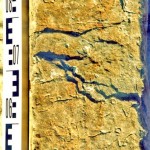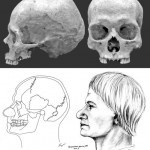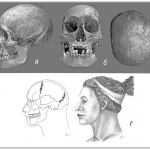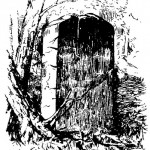The Middle Ages
The Abrau Peninsula and near Periphery in the Middle Ages
The end of antiquity in the Northern Black Sea region coincided with the beginning of a period of global movements in Eurasia of various ethnic groups and tribal alliances. This process which lasted from the 4th to 8th century, got the name of «the era of the great migration of peoples». It took on place the on Abrau peninsula, too.
In the 5th century in Crimea on Taman’ and on the Black Sea coast of the Western Caucasus Germanic tribes of goths got settled. In the area of Anapa, Novorossiysk, as the written data state in the 5th‒6th centuries. There had lived a tribe of goths and evdusians. They had left a famous cemetery, excavated in 1970 on the Dyurso river. Rich, full of inventory in this burial necropolis, especially accompanied by equine burial sacrifices of the warriors hade become the reference to the study of early medieval complexes of the antiquities of the Caucasus and Europe.
At the same time with the Goths, the nomadic tribes in to the plains of the peninsula start: penetrating the Huns, Bulgars, and from the 7th‒8th centuries – the Khazars. The state created by them became ‒ the Khazar Khaganate, it united the Abrau Peninsula and adjacent lands. In the area of Anapa they have found numerous settlements with the ceramic pottery typical for Saltovo-Mayatsk culture ‒ archaeological culture of the Khazar Khaganate. Notably one of them ‒ Utashskoe is, apparently, one of the centers of Christianity which came there from Byzantium. It is associated with a discovery of a Greek inscription on the construction of a certain Sebast Artemije temple in honor of the Transfiguration of the Lord, and dozens of tombstones with Christian symbolism. Links with the Byzantine Empire traced are according to numismatics data: in the Sukko Valley they found a treasure of Byzantine coins of the 7th‒8th centuries.
About the middle of the 8th century near Anapa and Novorossiysk appears a population that left mounds with burials of cremation ceremony (it is linked with a group of later burial cemetery on the Dyurso river). The local roots of the ritual and some elements of the culture of its carriers do not exist, but there are parallels in the antiquity of the Turkic-Ugric world. Here the arrival of a new population is connected, apparently, with the policy of Khazar Khaganate, whose rulers had used a practice of resettling the peoples subjected to them. Researchers link the carriers of the cremation ceremony with historical Kasogs known in this region due to the reports of the Byzantine, Arab and ancient Russian written sources. Judging by the abundance in male graves of weapons and accompanying the warriors in the graves together filled with equipped horses, the Kasogs were a community that had lived due to the military activities. Tmutarakan’ Prince Mstislav Udaloy fought against the Kassogs in 1022. The tradition to make cremation burials remained on the Black Sea coast and in Zakubanye the 13th century.
Since the end of the 12th century the Zikhes started settling in the region: they were the ancestors of the it Adygs – the Circassians who had lived before in the more eastern areas of the Black Sea coast. The fact of their presence already at that time is confirmed by the discovery near the Gostagaevskaya settlement of the funeral Greek inscription containing the names of Circassian origin. In the 13th century started penetrating into the mountains and forests of the Abrau peninsula hordes of the Kumans fleeing from the Mongol and Tatar invasion. They, according to the researchers, had brought in funerary traditions of the local population a burial custom of erecting a small mound, which the Circassians had kept up to the late Middle Ages.
In the same 13th century appear on the Black Sea and Azov coasts Italian colonies and trading posts, found originally by Genoa settlers. At the site of modern Anapa there was a colony called Mapa and near Novorossiysk ‒ Batarium village. The residents of the trading points had a good trade with the Circassians ‒ Adyges. Are an evidence of staying Italians here are tips of crossbow arrows and silver rings with heraldic symbols and Latin inscriptions.
In the gorges of the Abrau peninsula dozens of burial mounds of the 13‒14th centuries, had been found, they had been left by the Circassians. Some of them contain hundreds of mounds. Under the mounds usually are the tombs of stone slabs ‒ «stone boxes» containing single and collective burials. The funeral inventory is not rich: men’s burial with weapons, women’s with jewelry, handicraft items, ceramic and wooden utensils. There are finds of coins of the Golden Horde and Crimean Khanate.
During the excavation of the settlements they discovered numerous economic pits. The traces of the stone house building are not found, however, wreckage of burnt clay covered with prints of twigs. They point to the existence of wattle structures ‒ buildings whose walls were a fence, covered with clay. These findings correspond to the reports of the European travelers of that time, in particular George Interiano, on the absence of Circassian’s stone buildings and fortifications, and existence of buildings, woven of branches. Against this background, a unique settlement is open at Cape Maluy Utrish. There not only found numerous remains of stone structures, many of which seem to have been inhabited, but discovered a stone wall with a wide opening ‒ the gates, which was located near a «warehouse» ‒ clay-drum pithois dug into the soil.
In 1475 the Genoese colonies on the Black Sea were conquered by the Ottoman Turks. In Mape, which from that time got the name of Anapa, the Turkish garrison was stationed, and soon on the Sudzhuk (Tsemes) bay bank Sudzhuk-Calais (fortress) had been founded. In the centuries, which followed these lands were the scene of fierce fighting between the Ottoman Empire and the Russian Empire.
(Andrey N. Novichikhin)






